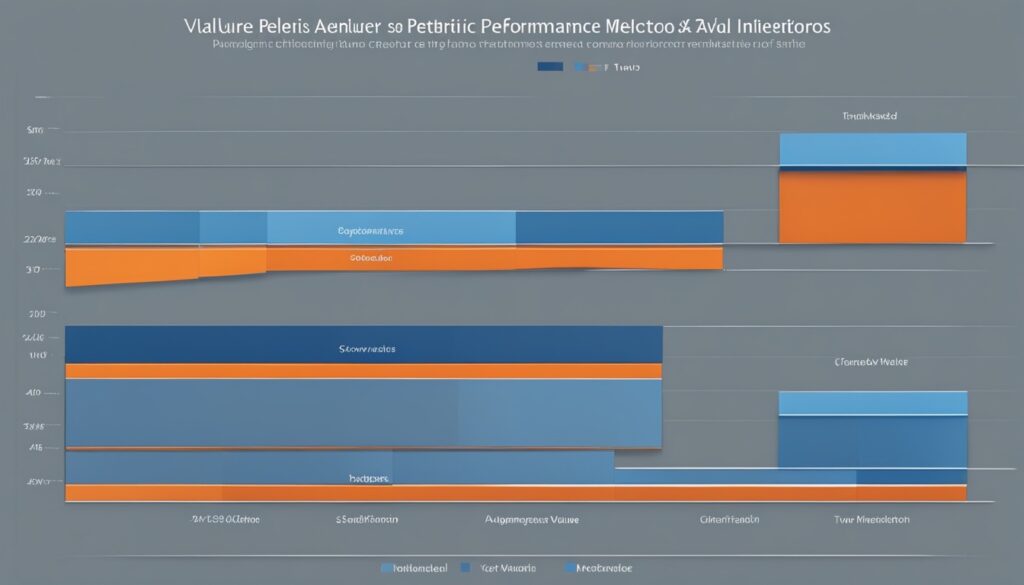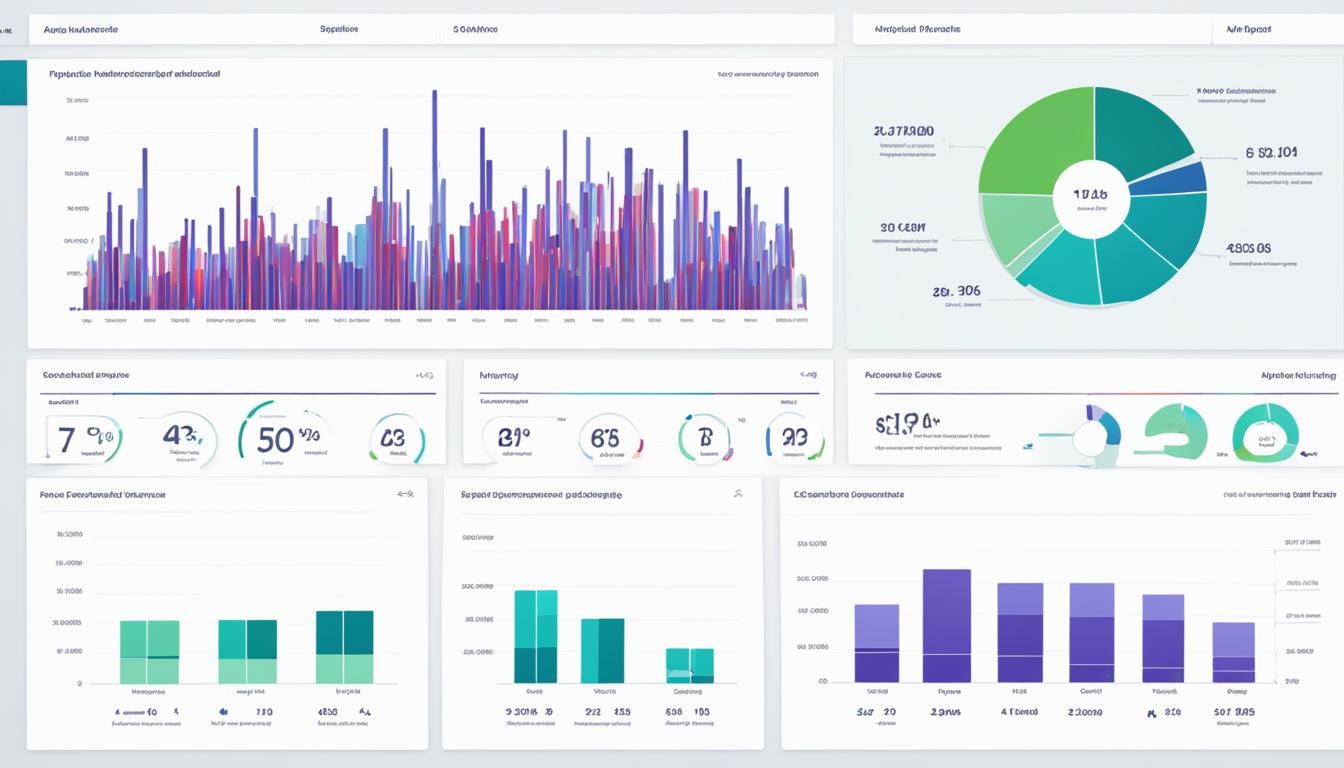Today, in the data-driven business world, software acquisition metrics and KPIs are vital. They help organizations measure the success of their IT investments. These metrics give insights into software procurement processes.
KPIs are measurable goals for software acquisition. They let businesses track their software investments’ performance. While metrics focus on detailed operations, KPIs look at strategic goals. These tools help build strong product plans and make smart business moves during software use.
Success in software acquisition needs a close look at finances, vendor performance, user engagement, and satisfaction. By watching these indicators closely, organizations can spot areas for growth. They can then improve, aligning their work with industry best practices.
Key Takeaways
- Software acquisition metrics and KPIs are essential for measuring the success of IT investments
- KPIs align with strategic objectives, while metrics focus on operational details
- Effective software acquisition metrics span financial, vendor performance, user adoption, and satisfaction indicators
- Data-driven decision making is crucial for optimizing software investments and maximizing returns
- A comprehensive approach to measuring software acquisition success enables continuous improvement and benchmarking
Understanding the Importance of Software Acquisition Metrics
Today, software acquisition metrics are key in the business world. They ensure IT investments are successful and efficient. These metrics give insights into software buying, helping companies make smart choices and use resources better.
They use key performance indicators (KPIs) and track specific measures. This lets companies match their software buys with big business goals. By doing this, they improve constantly.
The Role of Metrics in Data-Driven Decision Making
Making decisions based on data is vital for getting software right. Knowing proper metrics gives a thorough look at software buys. This way, organizations can make decisions that are backed by facts.
Metrics show trends and areas where getting better is possible. This helps improve processes, cut costs, and perform better overall. Software vendor metrics look at suppliers’ reliability and service quality.
Software cost metrics, on the other hand, help see if spending is efficient. They highlight places where money could be saved.
Aligning Metrics with Business Objectives
It’s crucial to line up metrics with the big aims of the business. Setting clear goals ensures software investments help reach strategic targets. For example, checking ROI on software shows its financial impact.
Tracking and reporting these metrics regularly helps in making data-backed choices. This can lead to business growth and increased competitiveness.
In short, software acquisition metrics are vital for better IT investments and smart decisions. Using KPIs and focusing on business goals ensures software adds significant value. It helps achieve long-term success.
Financial Metrics for Evaluating Software Acquisition Success
Looking at a software acquisition’s success means more than just looking at how much money it brings in. You need to consider different financial metrics. These metrics help you see how profitable and viable the software is in the long term. By watching and understanding these key financial indicators, companies can make smart choices. They can then adjust their strategies to get the most out of their software investments.
Return on Investment (ROI)
The return on investment (ROI) is a key metric for software acquisition success. It shows the financial gains compared to the costs of getting the software. To calculate ROI, look at how the software boosts productivity, saves money, and increases revenue. When the benefits exceed the costs, the software investment is seen as worthwhile.

Total Cost of Ownership (TCO)
The total cost of ownership (TCO) looks at all costs of the software over its whole life. This includes start-up costs and ongoing costs. Keeping track of TCO helps find chances to lower costs. It also ensures that the software purchase fits the company’s budget and goals.
Cost Savings and Cost Avoidance
Besides ROI and TCO, tracking cost savings and cost avoidance is also important. Cost savings are the actual savings made with the software, like cutting employee costs. Cost avoidance is what you save in the future, like avoiding buying new hardware.
| Financial Metric | Description | Formula |
|---|---|---|
| Return on Investment (ROI) | Measures the financial benefits gained from the software investment compared to the total costs incurred | (Net Benefits / Total Costs) x 100 |
| Total Cost of Ownership (TCO) | Encompasses all expenses associated with acquiring, implementing, and maintaining the software over its entire lifecycle | Sum of all costs (upfront and ongoing) |
| Cost Savings | Actual reduction in expenses achieved through the use of the acquired software | Previous Costs – Current Costs |
| Cost Avoidance | Potential future costs prevented by implementing the software | Estimated Future Costs Without Software – Estimated Future Costs With Software |
If companies keep track of these financial metrics, they can really understand how software affects the business. This approach lets companies make smart choices. It helps them plan for future software investments and ensures they meet their financial goals with new software.
Vendor Performance Metrics
When looking at different software vendors, it is key to have clear ways to measure their performance. This involves important metrics that should match your company’s objectives. Setting service level agreements (SLAs) with vendors helps set the right expectations. This means you can ensure they meet the performance levels you need.

It’s vital to manage your relationship with vendors effectively for any software purchase to work well. This means keeping in touch, checking how things are going, and solving any issues together. This approach builds a solid partnership. It helps you and the vendor work on problems early. This keeps their commitment to offering quality services and products.
A well-designed vendor performance scorecard should include metrics such as on-time delivery, quality of deliverables, responsiveness to support requests, and adherence to budget and timeline commitments.
Here are some important metrics to consider:
- On-time delivery rate
- Defect density
- Customer satisfaction scores
- Support response time
- Uptime and availability
| Metric | Description | Target |
|---|---|---|
| On-time delivery rate | Percentage of deliverables completed on or before the agreed-upon deadline | 95% |
| Defect density | Number of defects per 1,000 lines of code | <1.0 |
| Customer satisfaction score | Average rating of customer satisfaction on a scale of 1-5 | 4.5 |
| Support response time | Average time taken to respond to support requests | <4 hours |
| Uptime and availability | Percentage of time the software is available and functional | 99.9% |
It’s crucial to keep track of these metrics regularly. This ensures your vendors are meeting the standards. This approach helps you get the best from your contracts. It’s all about making smart decisions on renewals, changing service levels, and incentives. This leads to even more successful software buys.
User Adoption and Satisfaction Metrics
Success with software isn’t just about money. We also need to see if users are actually using and liking it. We look at how many people are using the software, and how much they’re using it. This helps us understand where users might need more help or training to use the software more.
To know if software is a hit, we must also see if people like it. The Net Promoter Score (NPS) shows how likely users are to recommend the software. Surveys and user feedback point out what’s not working well and what could be better. Actively listening and fixing these issues improves user satisfaction and loyalty.
Training and Support Effectiveness
Good training and support are key for happy users. We check things like who finishes training, if they remember it, and how well they can use the software. Assessing training helps improve it and makes users better at using the software. Support quality is also checked, like how quickly issues get fixed. This helps make sure users get the best help possible. Always making training and support better based on feedback helps everyone use and like the software more.




